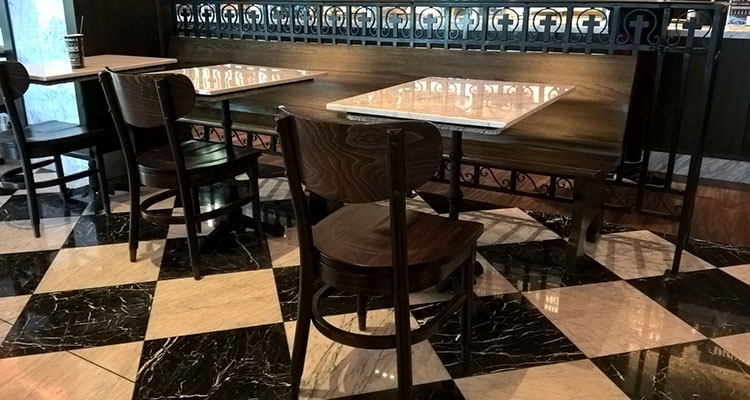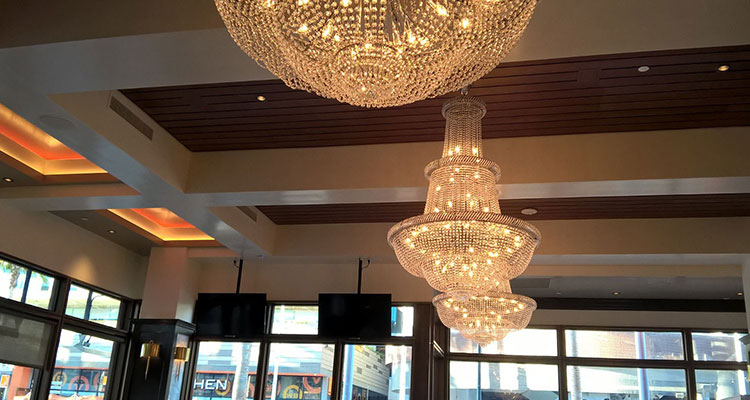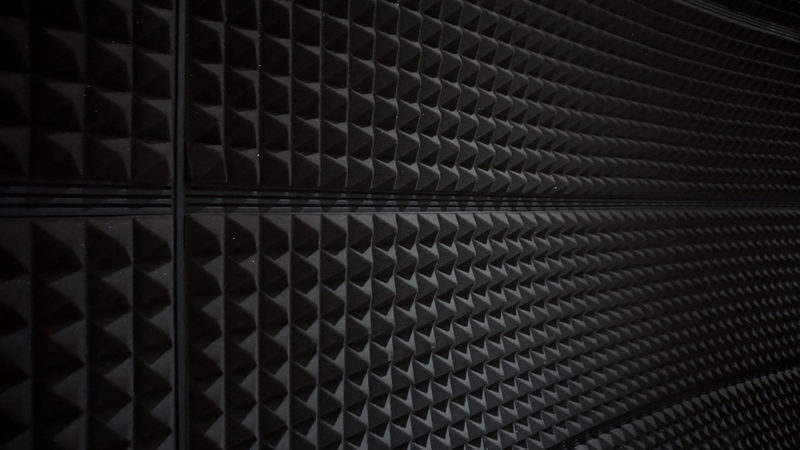Can You Hear Me? The Disgraceful Tale of the Three Chandeliers
Once upon a time, there was a great and renowned chef who was planning to open a prestigious restaurant in a highly prosperous suburb of a lovely city. He wanted to have not only stunning food, which he was quite sure he could provide, but also an exceptional architectural presentation and interior design as well. He commissioned a legendary craftsman to create for him three visually stunning chandeliers to illuminate and decorate his food palace.

He incorporated hand-built, custom fabricated marble topped cast metal tables, carefully fashioned beautiful marble floors and many other interior design elements to enhance the space.

But amidst all this visual beauty, one thing was forgotten — the essential purpose of the space from a human perspective.
As many of you know by now, I have been crying out from my orator’s soapbox about the failure of architects and interior designers to include acoustical treatment as a standard part of their designs thus making it possible for people to hold normal conversations in public spaces like the restaurant in our story.
I would add that it is important for audio system designers to offer acoustical treatment to their clients and it is important for those clients to insist on appropriate acoustical treatment in their initial consultation with architects and interior designers.
But, after half a lifetime (it seems) of furious debate with negligible improvement, perhaps it’s time to deploy a new army of good sound missionaries. After all, is it not essential that any space into which people enter to hold conversations, allow such communication to be heard with sufficient precision to be understandable by those people?
The voluptuous design and accoutrements of the esteemed chef’s food palace did not create such a possibility. For its marble, glass and metal made the room a giant echo chamber, and the chef’s customers could only hear a cacophony of sound with no clarity or distinction — and, despite great food, they were greatly disappointed by their “customer experience.”
ACOUSTICAL REALITY
While the fairy tale above is framed as a story, unfortunately, the reality is that this problem crops up every day, everywhere, in all kinds of spaces, with restaurants being consistently some of the most egregious examples.
Perhaps a bit of background is necessary.
Realistically, once you get to any room somewhat larger than a standard sized residential bathroom, you’re more than likely going to need some kind of acoustical absorption or diffusion to make the space useable for people and conversation. It might well be as simple as including thick under-carpet padding, or a significant amount of wall space taken up with filled bookcases, or even some sprayed on version of that fluffy looking ceiling popcorn type material home builders were so fond of 20 or 30 years ago.
Or it could be (wait for it) actual, real, calculated, professionally planned acoustical treatment based on proper science and methodology, plus real world measurements — Holy smokes, Dr. Sabine!
The essential issue here is that 99 percent of restaurants need it. Thus, any qualified architect/interior design team should have included it in the budget and their schematic plans and as submitted designs from day one. The discussion with the clients and owners should be about how much and where, not “oops, I forgot it again.” What would happen if the architects and interior design team forgot the bathrooms? Think anyone would notice that? Well…. both are equally essential to a functioning space.
Somehow this “Oops, I Did It Again” (to quote that notorious intellectual, Brittany Spears), attitude seems to be most prevalent within the restaurant design cosmos. Why they do it so routinely remains one of the great mysteries of the universe, but suffice to say it is absolutely positively, definitely and totally guaranteed to anger 4.9 out of five patrons.
While cogitating on this great mystery, the thought occurred that perhaps we should create and promote a special Facebook page called the Acoustic Fiasco “Hall of Shame” — highlighting an EPIC FAIL each month (although weekly wouldn’t be out of the question). Yes, it would be an immensely cheap and easy shot, but then there is that one example that rises so far above the norm as to deserve its own article — this one!
So…. the award goes to a project entitled “The Three Chandeliers.”
Let’s start with the basics. This restaurant is one of a planned chain.

As we look upon this work of utter genius from a reflected ceiling plan perspective, one notices the elegant custom Italian (read seriously high $$$) marble floor offering no acoustical absorption. The perimeter wall is half glass and half drywall, offering little surface area for treatments.
The high ceiling adds another second or so to the reverberation time and perhaps a few reflections, yet offers several obvious but initially unused [see below for the eventual result] opportunities to add acoustical absorption.

Now take a moment to have a longer look at the last (ceiling coves) photo. For any acoustician, even a novice, this should have been a slam dunk to resolve. A ten minute discussion, a costing and materials memo, and a couple of spec sheets would have easily done the job — UP FRONT, or even while construction was underway as long as final finishes had not yet been applied.
OK, so the answer is blatantly obvious and easily implemented. So the critical question becomes, “Was there no budget for acoustical absorption?” Clearly there was more than enough money for some posh “statement” three-tiered crystal chandeliers, custom marble floors, hand built dining tables, and I’m sure logoed china, maybe custom silverware, and of course embroidered uniforms or clothing for the staff, first class chef’s hats, six- to seven-figure kitchen fit-out and on and on. Oh, and I’m also sure the staff went to training to develop that slightly arrogant, cynical attitude necessary for such a high dollar dining experience, with menu pricing to match.
The irony of trying to have any sort of remotely useful spoken or heaven forbid musical content intrude into this gigantic hollow echo chamber of a space other than “Can you please repeat that?” is mildly entertaining. Oh and in case you missed them, look for the two dangling video monitors, which are switched off — anyone want to hazard a guess as to why?
Now the comeuppance. After about three months, and a continual litany of complaints, even some in the reviews from the hoity-toity food critics (local and national), magically time and budget were found to make use of the obvious space and install some effective acoustical absorption to this facility. I’m sure there was massive screaming and yelling from his highness the chef/owner and the top line staff about the three days they were temporarily closed for the needed work to be accomplished. But it was done — well after it should have been done and at a much higher cost (including three days of not serving big buck prix-fixe dinners). But where do you think they put it? And, by the way, a dark drape was hung over the glass facing the street during the work to hide the fact that it was being done — just too arrogant to admit their mistake!
Figured it out yet? Besides the you-can’t-see-it materials up in the ceiling, look closely at the tables. Each table bottom is carpeted with a fiberglass foam board material sandwiched above. A clever solution which while helpful could easily have been avoided, if the issue had been handled beforehand. Of course there was much hair tearing about the visual effect this had on those brutally costly custom marble table but oh well.
Unfortunately the conversation that would really have been revealing is lost to the echoes in the space. That is the one between the owner and the architect about the acoustics right before opening.
After all, the issue wasn’t just acoustical treatment. It was the lost perspective on the purpose of the space and the fact that genuine homo-sapiens with (assumedly) functional ears would be occupying it nightly. Didn’t anybody consider they might want to actually have a conversation?





